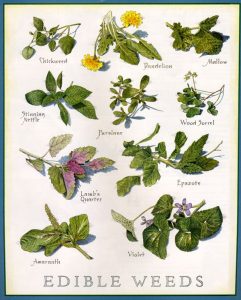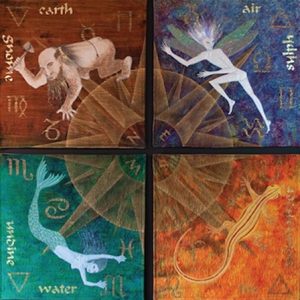I just wanted to add a little about the other lectures I attended at the Biodynamic Conference because, as is one of the foundational concepts of biodynamics, nothing truly stands alone and all is connected. Therefore, the wisdom of one lecture means so much more within the context of the other lectures, showing that all these topics are indeed inextricably interwoven, as is nature itself.
The Spirit of Healing Plants
with Deb Soule and Claudia J. Ford

photo: http://www.offgridhub.com/a-huge-list-of-edible-plants-and-weeds-for-survival/
These two remarkable women told us tales illuminating how healing plants have been present in our consciousness since deep antiquity. They told us how many origin stories show relationships to medicinal plants and how women have been especially connected to this knowledge. They spoke of how it is the spirit of the plant that heals, more than the plant’s chemical composition. Both are important, of course, but in aligning ourselves with a plants spiritual resonance, we are more receptive to its healing powers and also derive health from a closer relationship to growing things, which, by definition, are imbued with the life-force.
Working with Elemental Beings
with Cynthia and Harald Hoven

photo: http://realitysandwich.com/172485/four_elemental_beings/
Cynthia and Harald spoke to us about the elemental beings: gnomes of the earth, undines of the water, sylphs of the air, and salamanders of the fire. Through allegory and stories of personal experience, they showed us how the world of the elementals is a world that is deeply intertwined with the one we experience every day, but which is largely hidden from modern people. This, they said, is because rationality makes us blind. They said that the loss of intention, the rise of greed, and seeing things too physically distances us from elementals. From this talk we saw how elemental beings are present in many forms throughout nature, and that in order to contact them, we must slough off our way of seeing the world mechanistically and let them show themselves to us. We can interact with them by orienting our senses to coming from within nature instead of from outside of it.
Water Resilience on the Farm
with Don Bustos, Hugh Williams, and Don Tipping

photo: http://www.blockhill.co.nz
This talk focused on how to best work with the natural contours and inclinations of the land to form a symbiotic relationship between waterways and the caretakers thereof. In a time where water is becoming scarce in many areas of the planet and where many old ways of working with the land have been lost, this information is vitally important. Don Bustos spoke about the acequia system, which is a traditional method of flood irrigation systems. He stressed the importance of communing with the spirits of the plants and of the land. Hugh Williams told us about the Keyline design, which works with the natural contours of the land to create pond systems and waterways for flood irrigation. Don Tipping spoke about how the land dictates what will fit on a physical level; by following the natural ‘flow forms’ of the land, we can cultivate crops in patterns that are beneficial for ourselves, for the animals, and for the land.
Experiencing Soil and Compost Through Color, Form, and Pattern
with Bruno Follador

photo: Biodynamic Association of India
In the early 20th century, the pioneering soil scientist and influential early biodynamic practitioner Ehrenfried Pfeiffer used a form of copper chromotography to analyze the organic life forces present in soils, composts and living plants and animals. Since then, the technique has been used by many biodynamic researchers to find visual signifiers of the “etheric formative forces” spoken of by Rudolf Steiner. Bruno Follador, a researcher and philosopher who works at the Nature Institute in upstate New York, encouraged us in this workshop to experience the copper chromatographs produced by Pfeiffer’s method as works of organic poetry, without preconceptions about the significance of various forms and patterns found in them. His workshop ended by quoting William Herschel, the astronomer who discovered Uranus: “Seeing is an art.”
Leave a Reply